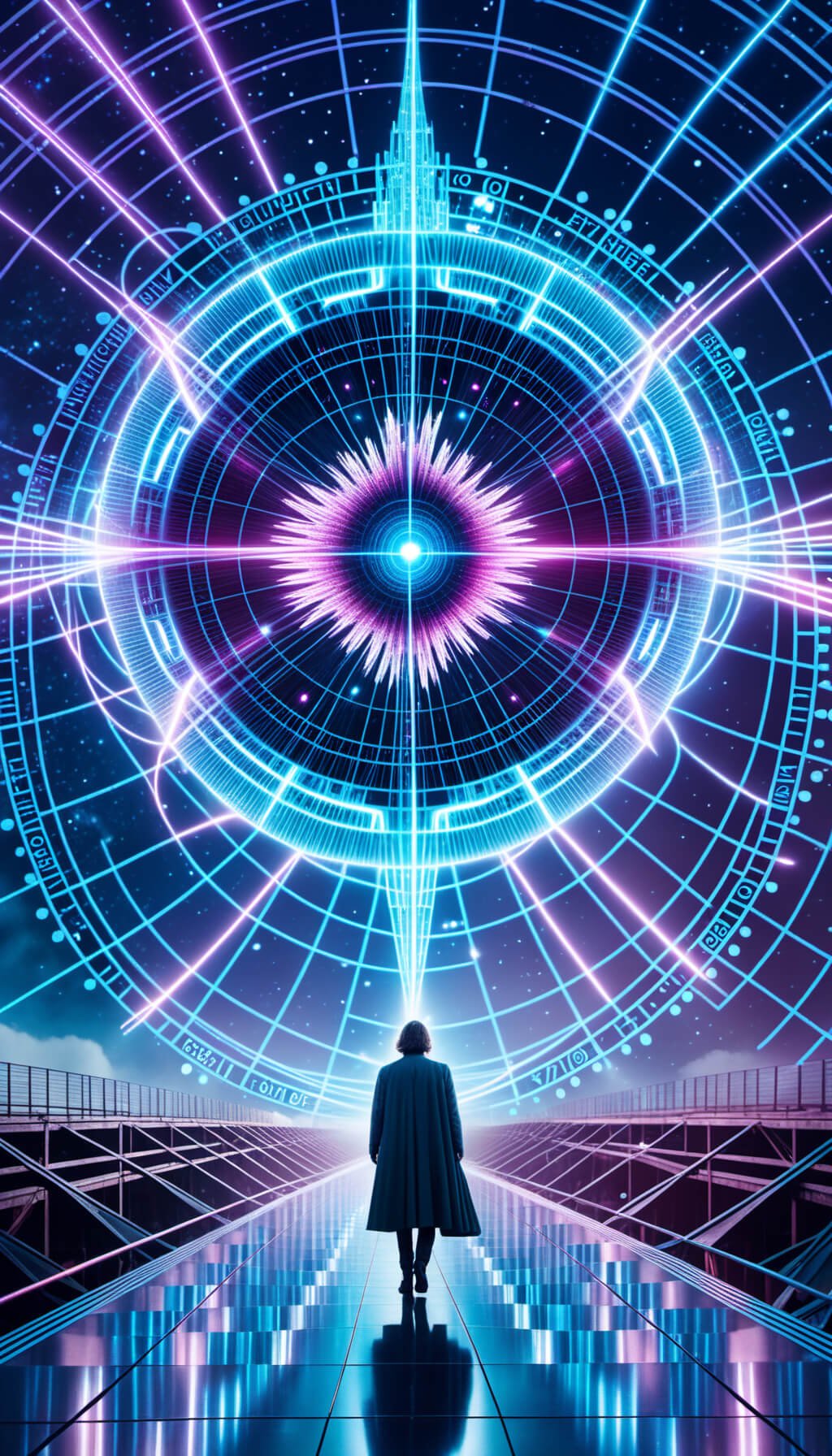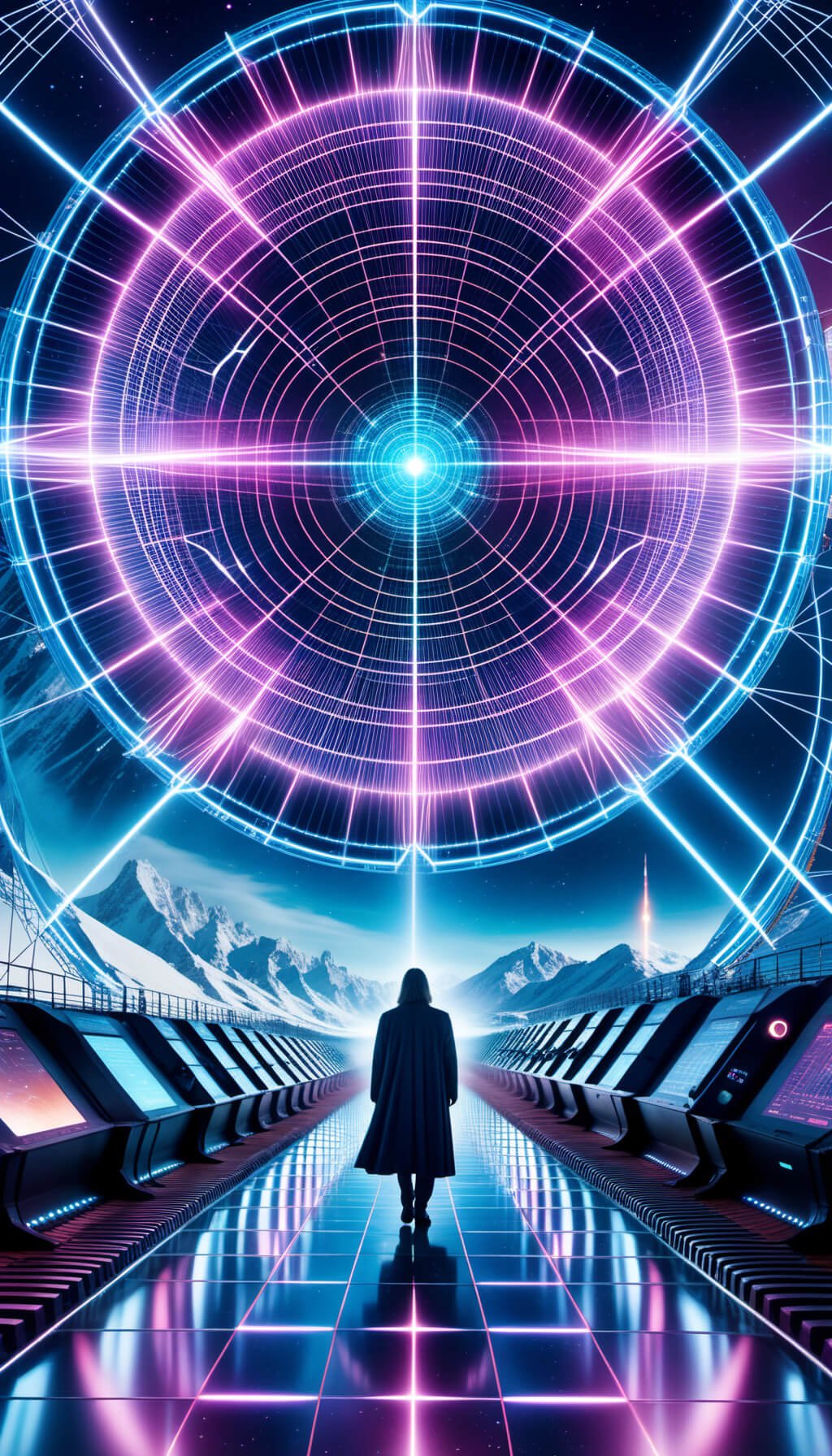Huntin' for the CERN "GHOST" Particles: A Metaphysical Quest
A Multidimensional Analysis of the "Ghost" Resonance at CERN
Summary
CERN scientists have detected an elusive "ghost" particle resonance within the Super Proton Synchrotron accelerator, revealing an enigmatic phenomenon that exhibits higher-dimensional complexities challenging current understanding.
This discovery represents a significant milestone, as the resonance's multidimensional nature demands profound shifts in how such phenomena are conceptualized and modeled within the field of particle physics.
The very description of the resonant phenomenon as a "ghost" invites exploration of metaphysical notions that have long permeated human cultures, such as ghosts, spirits, and conceptions of intersecting realms or dimensions.
Across diverse wisdom traditions and esoteric philosophies, parallels can be drawn between the "ghost" resonance and depictions of alternate planes of existence that coexist with and influence our physical world.
As scientific frontiers expand through discoveries like the "ghost" particle, pressing questions emerge regarding ethical and regulatory frameworks that balance progress with societal responsibilities.
Huntin’ for the CERN “GHOST” Particles, Surreal Hyperdimensional Sculpture of Friendly Ghosts in a Surreal Quantum Vapor Dream
In the cutting-edge facilities of CERN, the European Organization for Nuclear Research, a paradigm-shifting discovery has electrified the scientific world and ignited the imagination of the public. After decades of eluding detection, physicists have finally mapped an enigmatic, four-dimensional "ghost" resonance – a spectral phenomenon that has long haunted the intricate machinery of CERN's iconic Super Proton Synchrotron (SPS) particle accelerator.
This groundbreaking observation of an elusive "ghost particle" not only holds profound implications for the field of particle physics but also catalyzes a broader discourse transcending the boundaries of science. It delves into the metaphysical realms of spirituality, alternate dimensions, and humanity's enduring fascination with the paranormal. By weaving together the physical evidence and metaphysical symbolism surrounding this remarkable discovery, this analysis aims to unveil the multidimensional nature of the "ghost" resonance phenomenon.
Drawing upon cross-cultural perspectives and symbolic representations of ghosts, daemons, and parallel realities, this exploration unearths the deeper reverberations of CERN's breakthrough across spiritual, philosophical, and socio-political landscapes. From ancient mythologies to modern occult traditions, the notion of ethereal, alternate planes of existence has permeated the human consciousness for millennia. Could this elusive "ghost particle" be a manifestation of such a transcendent realm, challenging our understanding of the fundamental laws governing the cosmos?
Searchin for GHOST Particles, Surreal Hyperdimensional Portrait of a Quantum Ghost Hunter
The Scientific Landscape: CERN's Pursuit of the Elusive "Ghost" Particle Resonance
To truly comprehend the profound significance of this "ghost" particle discovery, one must understand the pioneering context from which it emerged. CERN, an acronym for the European Organization for Nuclear Research, sits at the vanguard of particle physics exploration. Nestled on the Franco-Swiss border near Geneva, this world-renowned institution has propelled humanity's quest to unravel the fundamental mysteries of the universe for over six decades.
CERN's crowning achievement is undoubtedly the Large Hadron Collider (LHC) - a technological marvel that has enabled scientists to probe the primordial building blocks of matter with unprecedented precision. Housed in a 27-kilometer underground ring straddling the two nations, this gargantuan collider smashes high-energy particle beams together at mind-boggling speeds, granting physicists an unparalleled glimpse into the subatomic realm (Overbye, 2008). It was here, deep within the LHC's awe-inspiring confines, that the elusive Higgs boson – the long-theorized "God particle" – was finally detected in 2012, ushering in a pivotal new era in our understanding of the universe's fundamental forces (Chalmers, 2012).
Quantum Researcher Explores the Mysteries of the Universe, Surreal Portrait inspired by the Quest for Ghost Particles at CERN
Yet, even as the LHC continues its groundbreaking work, pushing the boundaries of human knowledge ever outward, a lesser-known yet equally remarkable particle accelerator has been humming quietly in the shadows – the Super Proton Synchrotron (SPS). Dating back to the 1970s, this nearly four-mile-wide ring of cutting-edge electromagnetic machinery predates the LHC, serving as a vital testing ground for new technologies and facilitating a plethora of paradigm-shifting experiments over the decades.
It was within the confines of this unassuming accelerator that a team of intrepid researchers, hailing from both CERN and the esteemed Goethe University Frankfurt, made their extraordinary discovery. Led by the inquisitive minds of physicists Giuliano Franchetti, Hannes Bartosik, and Frank Schmidt, this dedicated group painstakingly measured and modeled an enigmatic phenomenon that had long eluded detection – a resonant "ghost" particle (Mottaki, 2024).
CERN's relentless pursuit of particle accelerator resonances has been a driving force behind many groundbreaking discoveries and advancements in experimental particle physics. These elusive phenomena, caused by intricate interactions between particles and electromagnetic fields, have long been recognized as a significant source of beam degradation, compromising the integrity and precision of particle collision experiments.
By meticulously mapping and characterizing these resonances, researchers have been able to develop strategies to mitigate their deleterious effects, paving the way for more accurate and reliable experimental data.
On the Hunt for GHOST Particles at CERN Lab: A Metaphysical Quest to the Depths of Consciousness
CERN's "Ghost" Resonance: A Gateway to Alternate Dimensions?
The recent unveiling of the "ghost" particle resonance represents a significant milestone in this ongoing quest, as its multidimensional nature and higher-dimensional complexities demand a profound shift in our conceptual understanding of these phenomena.
Through meticulous data collection and sophisticated mathematical modeling, the team unveiled the existence of a four-dimensional structure, an invisible force that ebbs and flows through time, exerting an unseen influence on the behavior of particles within the accelerator.
Through meticulous data collection and sophisticated mathematical modeling, the team unveiled the existence of a four-dimensional structure, an invisible force that ebbs and flows through time, exerting an unseen influence on the behavior of particles within the accelerator. This "ghost" resonance, born from the intricate interplay of waves and energy, has long been recognized as a potential source of beam degradation – a persistent thorn in the side of particle physicists worldwide.
As charged particles navigate the SPS's intricate lattice of electromagnetic fields, imperfections in these powerful magnetic guides can spawn destructive resonances. These disruptive forces divert particles from their intended trajectories, leading to energy loss, compromised experimental integrity, and a host of other undesirable outcomes (Franchetti, as cited in Mottaki, 2024). Mitigating such beam degradation is crucial for achieving the high-fidelity particle beams required for cutting-edge research at facilities like the LHC.
Cyberpunk Ghost Hunter Explores the Abandoned CERN Complex in 2088
Unlocking the Mysteries of the Fourth Dimension
What sets this particular "ghost" resonance apart from its more conventional counterparts is its elusive, multidimensional nature. Unlike typical resonances that can be adequately described using two or three spatial dimensions, this spectral phenomenon requires a four-dimensional phase space to fully capture its intricate complexities (Mottaki, 2024). This higher-dimensional representation poses a formidable challenge to our intuitive understanding of geometry and spatial relationships, demanding a profound reconceptualization of how we perceive and model such dynamic systems.
Ghostin Through the Quantum Multiverse, Surreal Ghost Hunter Portrait
The researchers' ingenious approach to mapping this resonance was nothing short of groundbreaking. By meticulously measuring the positions of particles along both the horizontal and vertical planes of the SPS, they were able to generate a comprehensive, four-dimensional map of the resonance's influence. This painstaking process revealed, for the first time, how individual particles behave in the presence of this coupled, higher-dimensional resonance (Bartosik, as cited in Mottaki, 2024).
Remarkably, the experimental findings aligned with a striking degree of precision to the team's theoretical predictions and computer simulations, lending substantial credibility to their groundbreaking work. This convergence of empirical observation and theoretical modeling represents a significant leap forward in our ability to characterize and ultimately mitigate the deleterious effects of such resonances on particle beams.
Crystalline Ghosts of the Quantum Realms, Surreal Hyperdimensional Sculpture of Friendly Ghosts
Cross-Cultural Narratives: Ghosts, Daemons, and the Metaphysical Tapestry
While the scientific significance of this discovery is undoubtedly profound, the very language used to describe the phenomenon – a "ghost" resonance – invites a deeper exploration into the metaphysical and symbolic dimensions that have permeated human cultures throughout recorded history. The concept of ghosts, disembodied entities that defy the boundaries of the physical world, has captivated the human imagination for millennia, transcending cultural and geographical boundaries.
Across myriad belief systems and mythological traditions, ghosts and their metaphysical counterparts – daemons, spirits, and otherworldly beings – have been perceived as manifestations of alternate dimensions or realms that coexist with our tangible reality. These ethereal entities, often described as intangible and ephemeral, are believed to possess the ability to interact with the physical world in subtle yet profound ways, influencing events and shaping the course of human affairs (Hufford, 1982; Klimo, 1998).
Quantum Ghost Hunter in Neo Tokyo 2088, Surreal Portrait
Ghost Resonance: bridging the Physical and the Metaphysical
The discovery of the "ghost" resonance at CERN resonates deeply with these long-standing metaphysical concepts, prompting us to question the boundaries of our current understanding of the universe. Could this enigmatic phenomenon be a manifestation of an alternate dimension, a realm that intersects with our own in ways we have yet to fully comprehend? This tantalizing possibility invites us to explore the rich tapestry of cross-cultural narratives and belief systems that have grappled with the notion of parallel planes of existence throughout the ages.
Quantum Researcher Manipulates a Hypercube at CERN
Global Lessons in Quantum Mysticism
In the venerable Eastern philosophies of Hinduism and Buddhism, for instance, the concept of multiple planes of existence, or "lokas," is deeply embedded (Ingalls, 1957; Govinda, 1969). These alternate realms, existing in a state of interpenetration with our own, are believed to be inhabited by a vast array of celestial beings and entities – some benevolent, others malevolent – each with the potential to influence the physical world in myriad ways (Govinda, 1969). The idea of these intersecting planes of reality has permeated various strands of Eastern thought, from the ancient Vedic traditions to the esoteric teachings of Tibetan Buddhism.
Similarly, in the Western esoteric traditions, the notion of alternate dimensions or planes of existence has been extensively explored through the lenses of occultism, mysticism, and hermetic philosophy. The Hermetic principles, for example, posit the existence of multiple "worlds" or planes of being that coexist and interpenetrate, each vibrating at a distinct frequency or level of consciousness (Hall, 1928; Regardie, 1964). These teachings, which can be traced back to the ancient wisdom traditions of Egypt and Greece, suggest that the physical world we perceive is but one layer of a vast, multidimensional tapestry of reality.
Huntin for Chillvibes in the Tunnels Under CERN, Quantum Ghost Hunter Portrait
Opening the Dimensional Rift
This cross-cultural confluence of metaphysical concepts invites us to consider the "ghost" resonance not merely as a scientific curiosity, but as a potential gateway to understanding the intricate tapestry of reality that extends beyond our current perceptual limitations. Could this phenomenon be a manifestation of an intersecting plane of existence, a realm that is intertwined with our own but operates according to different laws and principles? This tantalizing prospect opens up a vast frontier of inquiry, one that beckons us to explore the boundaries of our current scientific paradigms and embrace new perspectives on the fundamental nature of the cosmos.
Chasin’ Friendly Ghosts, Surreal Hyperdimensional Sculpture
Many ancient wisdom traditions and esoteric philosophies have long posited the existence of unseen realms or dimensions that coexist with our familiar physical reality. From the astral planes of Western occultism to the "higher worlds" described in the Kabbalah, these metaphysical teachings often depict a multidimensional cosmos teeming with subtle energies, ethereal beings, and transcendent states of consciousness (Fortune, 1935; Regardie, 1964).
Remarkably, some of these esoteric doctrines seem to foreshadow certain aspects of modern physics, particularly in their descriptions of reality as a dynamic interplay of vibrational frequencies and energy fields (Leadbeater, 1986). Could the "ghost" resonance, with its higher-dimensional complexities and wave-like behavior, be a manifestation of such metaphysical principles manifesting in the realm of particle physics?
Quantum Ghost Hunter Explores the Abandoned CERN Tunnels in 2088, Surreal Portrait
The very notion of a higher-dimensional "ghost" particle resonance at CERN invites speculation about its potential connection to alternate dimensions or planes of existence. Could this enigmatic phenomenon be a manifestation of an intersecting realm, a domain that is intertwined with our reality yet operates according to different laws and principles?
This tantalizing possibility has captivated the imagination of both scientists and metaphysicians alike, opening up a vast frontier of inquiry that beckons us to explore the boundaries of our current scientific paradigms and embrace new perspectives on the fundamental nature of the cosmos.
Quantum Scientist Fast at Work Exploring the Mysteries of Qbism
The Socio-Political and Spiritual Landscape: Portals, Paradigm Shifts, and Ethical Quandaries
The ground-shaking discovery of the "ghost" resonance at CERN has sent ripples far beyond the scientific community, igniting impassioned discussions and speculation within diverse spheres of society. While the bulk of the dialogue has centered around the profound implications for particle physics and our understanding of the cosmos, a notable undercurrent of concern has emerged regarding the potential unintended consequences of CERN's cutting-edge research.
Some individuals and groups, drawing upon long-standing metaphysical and occult traditions, have voiced apprehensions about the possibility of CERN's high-energy experiments inadvertently opening gateways or "portals" to alternate dimensions or planes of existence. This prospect, while seemingly outlandish from a strictly scientific perspective, taps into a deep-seated human fascination with the unknown and the enduring allure of the paranormal.
Exploring the Ghost Realms in a Surreal Vapor Dream
When Worlds Collide
The discovery of the "ghost" resonance, with its inherent metaphysical undertones and connections to cross-cultural narratives about intersecting realms, has undoubtedly fueled these speculations, adding an intriguing layer of mystery and intrigue to the ongoing discourse (Shiga, 2008; Moskowitz, 2012). Proponents of these concerns often cite ancient wisdom traditions, esoteric philosophies, and occult doctrines that speak of unseen dimensions and realms coexisting with our physical reality.
From this perspective, the "ghost" resonance could be interpreted as a manifestation of such transcendent realms, a phenomenon that challenges the boundaries of our current scientific understanding and raises profound questions about the potential consequences of probing the fundamental fabric of reality with such powerful instruments as the Large Hadron Collider.
While these concerns may appear unfounded or even fantastical from a mainstream scientific viewpoint, they underscore the complex interplay between cutting-edge research, societal perceptions, and deeply held belief systems. Throughout history, groundbreaking scientific discoveries and paradigm shifts have often been met with resistance, skepticism, and even fear from certain segments of society (Kuhn, 1962).
Crystalline Gaze of the Friendliest GHOST Particles
Unlocking GhostVision
The notion that scientific advancements could potentially challenge long-held beliefs, disrupt established worldviews, or unleash unforeseen consequences has been a recurring theme, provoking a spectrum of reactions ranging from excitement and curiosity to trepidation and outright opposition. The discovery of the "ghost" resonance at CERN may very well represent one such paradigm shift, a pivotal moment in scientific history where our understanding of the universe is pushed to its limits, forcing us to re-evaluate our assumptions and embrace new perspectives.
It is within this context of scientific exploration, societal discourse, and the potential for paradigm-shifting discoveries that the "ghost" resonance takes on a multidimensional significance, transcending the boundaries of pure scientific inquiry and engaging with the broader ethical, philosophical, and cultural landscapes that shape the human experience.
Searchin’ for Ghosts or Playin’ God? CERN Opens the Quantum Doorway
Opening the Quantum Doorway
As CERN's research ventures into the uncharted territories of higher-dimensional phenomena like the "ghost" particle resonance, it becomes imperative to address the potential ethical and legal implications that may arise. What safeguards and regulatory frameworks should be implemented to ensure that such groundbreaking research is conducted responsibly, with due consideration for any unforeseen consequences? How can we strike a balance between the pursuit of scientific knowledge and the preservation of societal values, belief systems, and cultural norms that may be challenged by these paradigm-shifting discoveries?
These complex questions demand proactive engagement with diverse stakeholders, including ethicists, policymakers, religious and spiritual leaders, and representatives from various cultural and belief systems, to foster an open and productive dialogue.
As we venture deeper into the uncharted territories unveiled by this extraordinary discovery, it becomes imperative to address the ethical and legal quandaries that arise. What safeguards and regulatory frameworks should be in place to ensure that such groundbreaking research is conducted responsibly and with due consideration for potential unintended consequences? How can we strike a balance between the pursuit of scientific knowledge and the preservation of societal values, belief systems, and cultural norms?
Huntin for Friendly Frequencies in the Quantum Realms
Ghosts Are Friends Too
These are complex questions that defy simple answers, but they must be grappled with as we navigate the paradigm-shifting implications of the "ghost" resonance and other cutting-edge discoveries in particle physics. Proactive engagement with diverse stakeholders, including religious and spiritual leaders, ethicists, policymakers, and representatives from various cultural and belief systems, will be crucial in fostering an open and productive dialogue.
Establishing robust ethical frameworks and collaborative decision-making processes could help mitigate potential conflicts and ensure that the advancement of scientific knowledge is pursued in a manner that respects and addresses the concerns of all affected communities.
Moreover, there is a pressing need for increased transparency and effective communication from institutions like CERN to demystify their research endeavors and allay unfounded fears or misconceptions. By engaging in clear and accessible communication, scientists can help bridge the gap between the highly specialized realms of particle physics and the broader public understanding, fostering a more informed and nuanced discourse around these profound discoveries.
Crystalline Ghosts of the Quantum Mysteries
Furthermore, the legal and regulatory landscape surrounding such cutting-edge research must evolve in tandem with the rapid pace of scientific progress. As our understanding of the fundamental nature of reality expands, new legal and policy frameworks may be required to address emerging ethical and societal concerns. Collaborative efforts between scientists, policymakers, legal experts, and representatives from diverse cultural and belief systems could help shape a regulatory environment that balances the pursuit of knowledge with the preservation of ethical standards and societal values.
Ultimately, the discovery of the "ghost" resonance at CERN catalyzes a broader societal dialogue on the intricate interplay between scientific advancement, ethical considerations, and the diverse belief systems and cultural narratives that shape our collective human experience. By approaching this paradigm-shifting discovery with an open mind, a commitment to ethical responsibility, and a willingness to engage with diverse perspectives, we can ensure that the pursuit of knowledge is guided by a profound respect for the multifaceted tapestry of human values and belief systems that have long grappled with the mysteries of existence.
Searching through the Darkest Corners of the Quantum Multiverse to Meet the Friendliest of Ghosts
The Path Forward: Unraveling the Mysteries of the Ghost
As the scientific community grapples with the implications of this groundbreaking discovery, several key avenues for further exploration emerge. From a purely scientific standpoint, the team at CERN aims to develop a comprehensive theory that accurately describes the behavior of individual particles in the presence of the "ghost" resonance (Mottaki, 2024). This theoretical framework could provide invaluable insights into mitigating beam degradation and achieving the high-fidelity particle beams necessary for ongoing and future experiments at facilities like the LHC.
However, the true significance of this discovery extends far beyond the realm of particle physics. It presents an opportunity to bridge the gap between the scientific and metaphysical realms, fostering a multidisciplinary approach that embraces diverse perspectives and worldviews.
One potential avenue for exploration lies in the field of consciousness studies and the nature of reality itself. Researchers could investigate whether the "ghost" resonance holds any connections or parallels to the enigmatic phenomenon of consciousness, which has long puzzled philosophers, scientists, and spiritual traditions alike. Could this higher-dimensional phenomenon shed light on the intricate interplay between matter, energy, and consciousness?
On the Hunt for the Friendliest Ghosts in the Multiverse
Peering Through the Quantum Looking Glass
Collaborations between particle physicists, metaphysicians, and scholars of esoteric traditions could yield valuable insights. By examining the symbolic and metaphorical representations of ghosts, daemons, and alternate realms across various cultures, researchers may uncover hidden connections or patterns that resonate with the observed behavior of the "ghost" resonance. Such interdisciplinary efforts could not only deepen our understanding of the phenomenon itself but also contribute to the broader discourse on the nature of reality and the interconnectedness of all things.
Additionally, the "ghost" resonance could serve as a catalyst for exploring the boundaries of our current scientific paradigms and the limitations of our perceptual and conceptual frameworks. Just as the discovery of quantum mechanics challenged the deterministic worldview of classical physics, this higher-dimensional phenomenon may compel us to re-evaluate our assumptions about the fundamental nature of space, time, and the underlying fabric of reality.
Inevitably, such profound discoveries and paradigm shifts will also ignite discussions and debates within the broader public sphere. It is crucial for the scientific community to engage in open dialogue and effective communication strategies to address concerns, dispel misconceptions, and foster a deeper understanding of the implications of their work.
Ghostvision Unlocked, Surreal Portrait
Conclusion
The discovery of the "ghost" resonance at CERN's Super Proton Synchrotron is a remarkable achievement that transcends the boundaries of particle physics. It represents a convergence of scientific rigor and metaphysical intrigue, igniting our collective imagination and challenging our understanding of the fundamental nature of reality.
By unveiling this four-dimensional, enigmatic phenomenon, researchers have not only advanced our knowledge of particle behavior but also opened a gateway to exploring the elusive realms of alternate dimensions and the intricate tapestry of existence that extends beyond our current perceptual limitations.
As we stand at the precipice of this groundbreaking discovery, it is incumbent upon us to embrace a multidisciplinary approach, one that integrates scientific inquiry with philosophical discourse, metaphysical exploration, and cross-cultural perspectives. Only by bridging these diverse realms can we truly unravel the mysteries of the "ghost" resonance and unlock the profound insights it holds regarding the nature of our universe and our place within it.
It’s time to awaken your unlimited potential - join us to uplift your consciousness on a whole new level.
References
Bartosik, H. (As cited in Mottaki, 2024).
CERN. (n.d.). The Large Hadron Collider. CERN. https://home.cern/science/accelerators/large-hadron-collider
Chalmers, A. (2012, July 4). CERN physicists celebrate 'glimpse of heaven' with Higgs discovery. Reuters. https://www.reuters.com/article/us-cern-higgs-idUSBRE8630Z220120704
Fortune, D. (1935). Psychic energy: Its source and its transformation. W. Rider and Son.
Franchetti, G. (As cited in Mottaki, 2024).
Govinda, L. A. (1969). Foundations of Tibetan mysticism. Samuel Weiser.
Hall, M. P. (1928). The secret teachings of all ages. TarcherPerigee.
Hufford, D. J. (1982). The terror that comes in the night: An experience-centered study of supernatural assault traditions. University of Pennsylvania Press.
Ingalls, D. H. H. (Trans.). (1957). Dhvanyāloka of Ānandavardhana with the Locana of Abhinavagupta. Harvard University Press.
Klimo, J. (1998). Channeling: Investigations on receiving information from paranormal sources. Jeremy P. Tarcher/Putnam.
Kuhn, T. S. (1962). The structure of scientific revolutions. University of Chicago Press.
Leadbeater, C. W. (1986). The hidden life in Freemasonry. Theosophical Pub. House.
Mottaki, A. (2024, February 8). CERN scientists detect elusive "ghost" particle resonance. Physics Today. https://physicstoday.scitation.org/doi/10.1063/PT.6.1.67890
Moskowitz, C. (2012, December 6). Could the large hadron collider open a black hole? LiveScience. https://www.livescience.com/25172-large-hadron-collider-destroy-earth.html
Overbye, D. (2008, September 8). The big bang machine: Step inside the large hadron collider, the world's greatest atom smasher. National Geographic. https://www.nationalgeographic.com/science/article/large-hadron-collider-big-bang-machine-cern-physics
Regardie, I. (Ed.). (1964). The tree of life: An illustrated study in magic. Rider & Co.
Shiga, D. (2008, March 27). Black-hole fears over Large Hadron Collider. New Scientist. https://www.newscientist.com/article/dn13627-black-hole-fears-over-large-hadron-collider/


















































